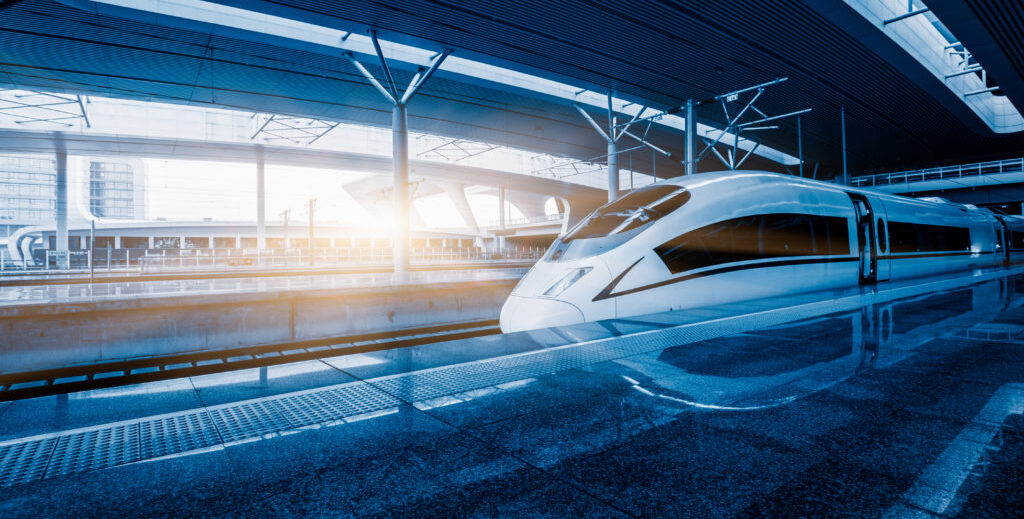Urban Infrastructure Lab, Mobility Innovation Center, and Challenge Seattle see potential in the Pacific Northwest

On the Media
New Scientists: Has the US Finally Figured out How to Do High-speed Rail? (04/22/2024)
The Hill: High-speed Rail is a Huge Opportunity for American Workers (09/03/2023)
The South Seattle Emerald: Plans Develop for High-Speed Rail in the PNW (07/18/2023)
The Urbanist Podcast: UW Looks at Getting Cascadia High Speed Rail (06/17/2023)
A new research report out of the University of Washington examines data on high-speed rail systems around the world to mine key insights on how a similar undertaking could work in the Cascadia region, a source of considerable investment and opportunity for agencies and private sector partners.
The report comes as Washington’s state legislature has allocated $150 million to begin planning efforts for a high-speed connection between Oregon and British Columbia. The study, launched by the Mobility Innovation Center (MIC), was supported by Challenge Seattle and led by the Urban Infrastructure Lab at the UW’s College of Built Environments.
Jan Whittington, associate professor in UW’s Department of Urban Design and Planning and director of the Urban Infrastructure Lab, led the research with Qing Shen. Their work involved more than 50 hours of interviews with industry experts, as well as case studies and literature reviews, with the goal of learning from existing systems in Europe and Asia and new projects in development within the U.S. and sharing useful findings with transportation agencies, potential partners, and decision makers.
“Massive infrastructure projects can be transformative for a region’s quality of life and economic competitiveness,” Whittington said. “Our research has uncovered several themes among successful projects and the identified decisions that have steered other projects off course.”
The following trends and best practices emerged:
Focus on service and providing value in the transportation market. Prioritize providing competitively fast and convenient service, bring in industry experts, and shore up public engagement.
A program of this magnitude calls for a new institutional approach to avoid politically influenced expert decision-making and political renegotiation. High-speed rail is more complex than a highway project, for example, and requires innovative approaches. For projects in the U.S. and Canada, success will depend on avoiding the cycle of underestimates, overruns, and political renegotiation.
Effective and productive private sector relationships. Successful projects depend on staffexperts with knowledge and experience in high-speed rail project development and delivery to navigate both the technical and political landscape, and provide an opportunity for firms to participate fairly and provide value to the public.
Coordinated public engagement. The trust and support of partners and service communities depends on fair and transparent decision making and coordinated public engagement at all stages of development. Invite the community into the discussion early.
Leverage funding streams. High-speed rail megaprojects are expensive, but there are opportunities to reduce potential costs to the system, such as using existing right of way, and to leverage future real estate development along the transit corridor.
Plan slow, act fast. Take time for planning, public engagement, public agreements, engineering, permitting, and environmental review, and don’t hire contractors until you’re ready to dig into design and construction.
“New ideas and innovative approaches are needed to solve the challenges ahead and propel us toward a cleaner, more inclusive, and resilient future,” said Bart Treece, director of UW’s Mobility Innovation Center. “This report can help leaders in Cascadia and other parts of the world who want to invest in large-scale rail projects, take the next step with more clarity, and make the best decisions possible.”
Earlier this year, the Washington State Department of Transportation applied for federal funding to begin early-stage planning for an ultra-high-speed connection between British Columbia, Washington, and Oregon. This follows previous studies that examined the feasibility and business case for advancing a transportation system that could travel at speeds up to 250 mph. “Connecting the three major cities in our megaregion with faster and more reliable service is a vision that could transform the Pacific Northwest,” said Ron Pate, WSDOT’s Director for Rail, Freight and Ports. “The University of Washington’s report reaffirms we are on the right track and outlines best practices we will continue to implement in our current efforts, as well as when federal funding is awarded and we move forward with public outreach and planning for this program.”